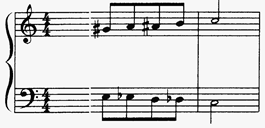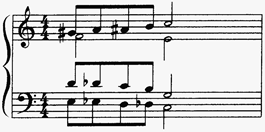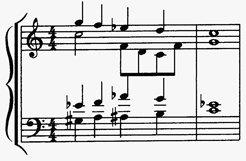Each chord can be preceded and approached by a chord of same quality :
|
Situated ½ tone higher or lower |
Chromatic Approach |
|
|
When its notes belong to the mode |
Diatonic Approach |
|
|
When the approaching intervals are similar |
Diatonic Approach |
These specific approaches correspond to the "sectional" harmonization found in jazz and pop music.
1. The chromatic
approach
a. The note intervals and the direction of both chords are similar :
|
|
|
1/2 tone |
b. All harmonic intervals are allowed :
 |
|
|
Parallel 8ves |
Parallel 5th and 8ves |
|
|
|
c. The use of the 7th and dissonances, softens the parallelism :
 |
|
Good |
|
|
d. The parallelism can include 2 or several chords. In this case, it depends on the final chord :
 |
|
Parallel chromaticism / arrival chord |
|
|
e. This chromatic parallelism can be used inside "sequences", and be more distant :
 |
2. Diatonic approach
on a given scale
a.
Two consecutive chords on a diatonic scale :
 |
| C harmonic minor |
Notice : The intervals between the notes of the chords are not similar and are built on a "C harmonic minor" scale.
b. The diatonic approach is used for diatonic melodies :
 |
| F lydian mode |
c. Unlike the chromatic approach, the diatonic parallelism can be used with distant chords :
 |
| F major |
In this case, each note moves to the next chord by the same interval as the melody :
 |
| Augmented 4th |
4. The contrary harmony
a. The superimposition of 2 scales going opposite directions gives some original diatonic and chromatic harmonizations :
 |
| C mixolydian modes |
b. Example on a diatonic scale :
 |
| 2 diatonic scales in C major |
 |
| Harmonization |
c. Example with a chromatic scale :
 |
| 2 contrary chromatic scales |
 |
| Harmonization |
d. Diatonic and chromatic combination :
 |
| Diatonic + chromatic scales |
 |
| Harmonization |
e. Different note values :
Contrary scales can include different le-rythmes :
 |
|
2 notes VS 1 note |
|
|
|
Harmonization |
|
|